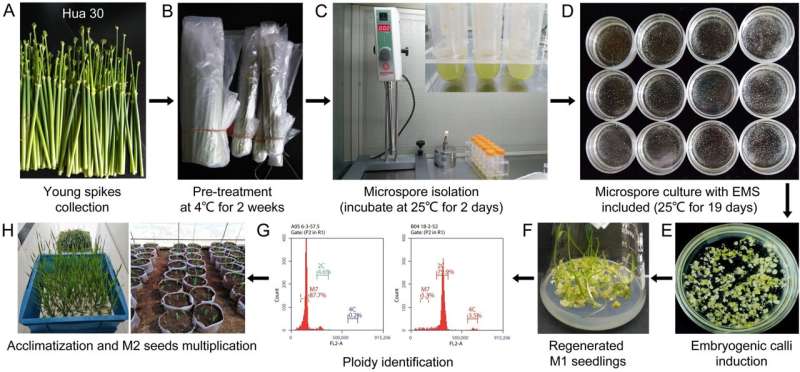This article has been reviewed according to Science X's editorial process and policies. Editors have highlighted the following attributes while ensuring the content's credibility:
fact-checked
proofread
Generating homozygous mutant populations of barley microspores by ethyl methanesulfonate treatment

A new study combined expertise in barley genetics and genomics from the research group led by Dr. Ping Yang (Institute of Crop Sciences, Chinese Academy of Agricultural Sciences) and that in barley microspore culturing led by Dr. Chenghong Liu (Biotech Research Institute, Shanghai Academy of Agricultural Sciences), in order to address the time- and space-cost issue in developing homozygous induced mutants, which are very important genetic resources in theoretical researches as well as pre-breeding.
The researchers applied chemical mutagenesis (ethyl methanesulfonate, EMS) on the medium of barley microspore culture, then produced the haploid mutations that could become homozygous in the regenerated plants which are double haploids (DH).
The barley genotypic effect, as well as the mutagen dosage effect, were estimated by combining evaluation of the genome-wide density of mutations via high-throughput sequencing, thus providing reference for future optimizing of this approach. The research is published in the journal aBIOTECH.
"Routinely with seed treatment, the heterozygosity of early-generation plant populations produced by chemically induced mutagenesis makes it difficult to identify phenotypic variation in quantitative or recessive traits," said Dr. Yang. "Mutagenesis of isolated microspores is able to produce DH lines with fixed homozygous mutations, and the plants with phenotypic alterations had been recognized at a very early generation."
"Moreover, millions of haploids can be treated in a highly space-saving manner," said Dr. Liu. "Combining induced mutagenesis with the microspore culture would largely speed up developing novel genetic resources which are applicable in pre-breeding."
In addition to generating barley population with thousands of homozygous mutants, this research provides an effective approach to development of novel genetic resources and could be a valuable reference for practice in other crops.
More information: Linli Huang et al, Generating homozygous mutant populations of barley microspores by ethyl methanesulfonate treatment, aBIOTECH (2023). DOI: 10.1007/s42994-023-00108-6
Provided by Beijing Zhongke Journal Publising Co. Ltd.



















